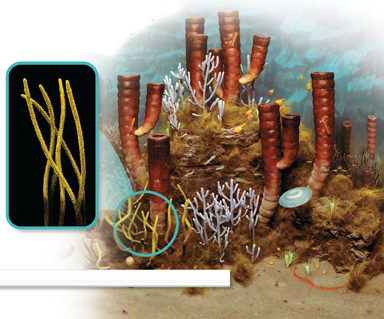22.2 Seedless Plants
 What are the characteristics of green algae?
What are the characteristics of green algae? What factor limits the size of bryophytes?
What factor limits the size of bryophytes? How is vascular tissue important?
How is vascular tissue important?
bryophyte • vascular tissue • archegonium • antheridium • sporangium • tracheophyte • tracheid • xylem • phloem
Venn Diagram Construct a Venn diagram in which to record similarities and differences among the three major groups of seedless plants. Fill it in as you read the lesson.
THINK ABOUT IT We generally think of plants as growing from seeds. But there are plenty of plants, such as mosses, ferns, and green algae, that don't produce seeds at all. How do they manage to reproduce and grow without them?
Green Algae
 What are the characteristics of green algae?
What are the characteristics of green algae?
What do you think of when you hear the word algae? You might think of seaweed, given that algae make up the most common forms of seaweed, and the singular form of the word, alga, actually means “seaweed” in Latin. As we use the word today, the algae are not a single group of organisms. Biologists apply the name to any photosynthetic eukaryote other than a land plant. As a result, some algae are classified as protists and others are classified as plants. Those algae that are grouped with plants are called green algae.  DOL•21
DOL•21
The First Plants Fossil evidence suggests that the green algae were the first plants, appearing on Earth before plants first emerged on land. In fact, fossil formations from the Cambrian Period, more than 550 million years ago, show evidence of large mats of green algae.
The green algae share many characteristics—including their photosynthetic pigments and cell wall composition—with larger, more complex plants.  Green algae are mostly aquatic. They are found in fresh and salt water, and in some moist areas on land. Because most green algae are single cells or branching filaments, they make direct contact with the water in which they grow. They are able to absorb moisture and nutrients directly from their surroundings. Therefore, most green algae do not contain the specialized tissues found in other plants.
Green algae are mostly aquatic. They are found in fresh and salt water, and in some moist areas on land. Because most green algae are single cells or branching filaments, they make direct contact with the water in which they grow. They are able to absorb moisture and nutrients directly from their surroundings. Therefore, most green algae do not contain the specialized tissues found in other plants.

FIGURE 22–7 Early Plants and Animals Primitive green algae shared the ocean floor with corals and sponges in the Middle Cambrian Period, about 500 million years ago.

Table of Contents
- Formulas and Equations
- Applying Formulas and Equations
- Mean, Median, and Mode
- Estimation
- Using Measurements in Calculations
- Effects of Measurement Errors
- Accuracy
- Precision
- Comparing Accuracy and Precision
- Significant Figures
- Calculating With Significant Figures
- Scientific Notation
- Calculating With Scientific Notation
- Dimensional Analysis
- Applying Dimensional Analysis




